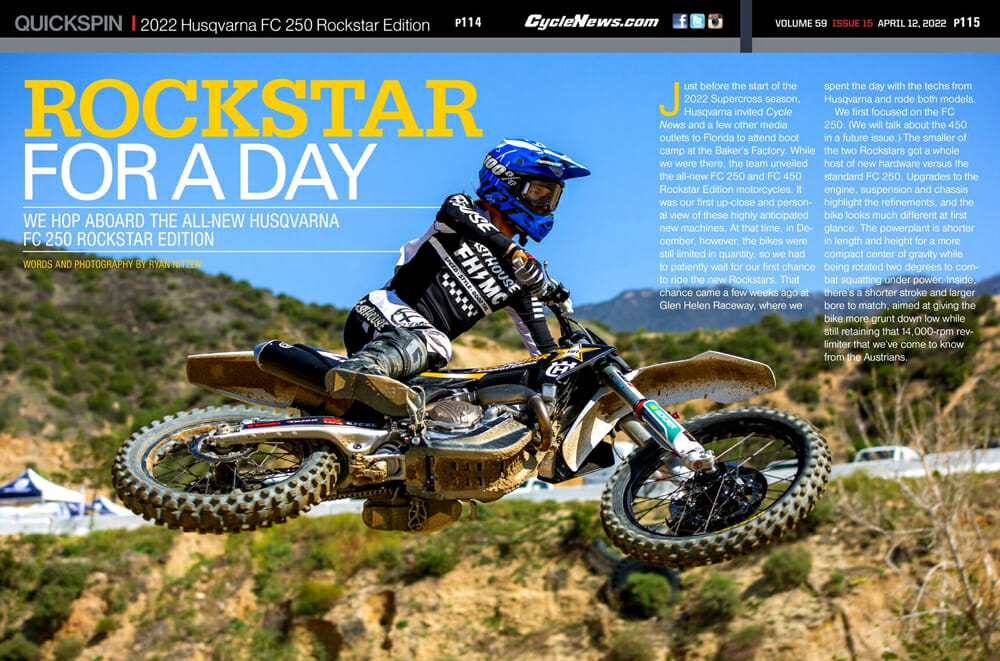Ryan Nitzen | April 14, 2022
We hop aboard the all-new Husqvarna FC 250 Rockstar Edition
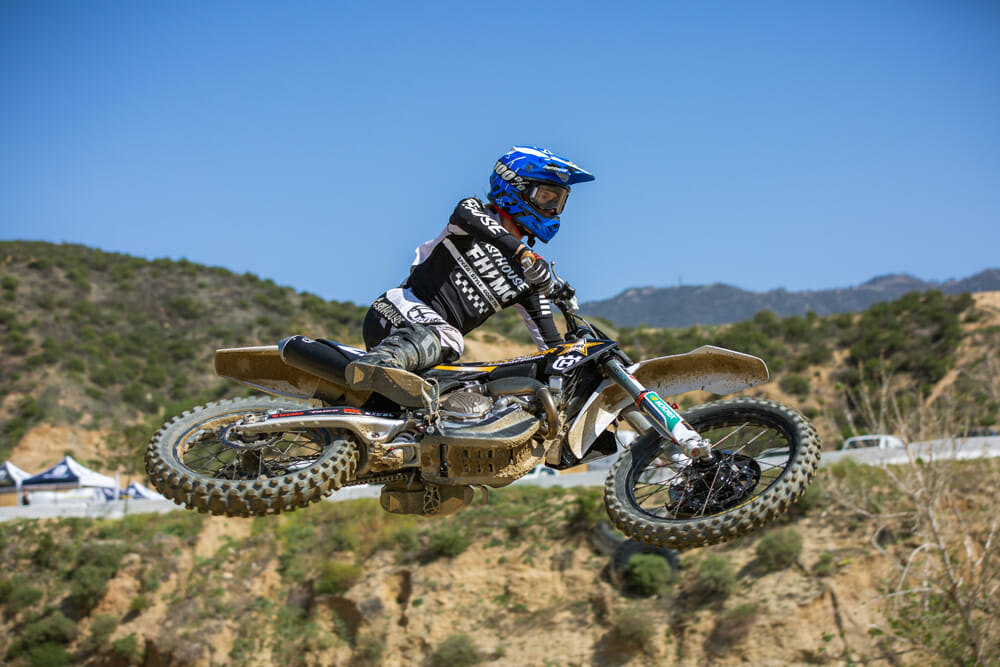
Photography by Ryan Nitzen
Just before the start of the 2022 Supercross season, Husqvarna invited Cycle News and a few other media outlets to Florida to attend boot camp at the Baker’s Factory. While we were there, the team unveiled the all-new FC 250 and FC 450 Rockstar Edition motorcycles. It was our first up-close and personal view of these highly anticipated new machines. At that time, in December, however, the bikes were still limited in quantity, so we had to patiently wait for our first chance to ride the new Rockstars. That chance came a few weeks ago at Glen Helen Raceway, where we spent the day with the techs from Husqvarna and rode both models.
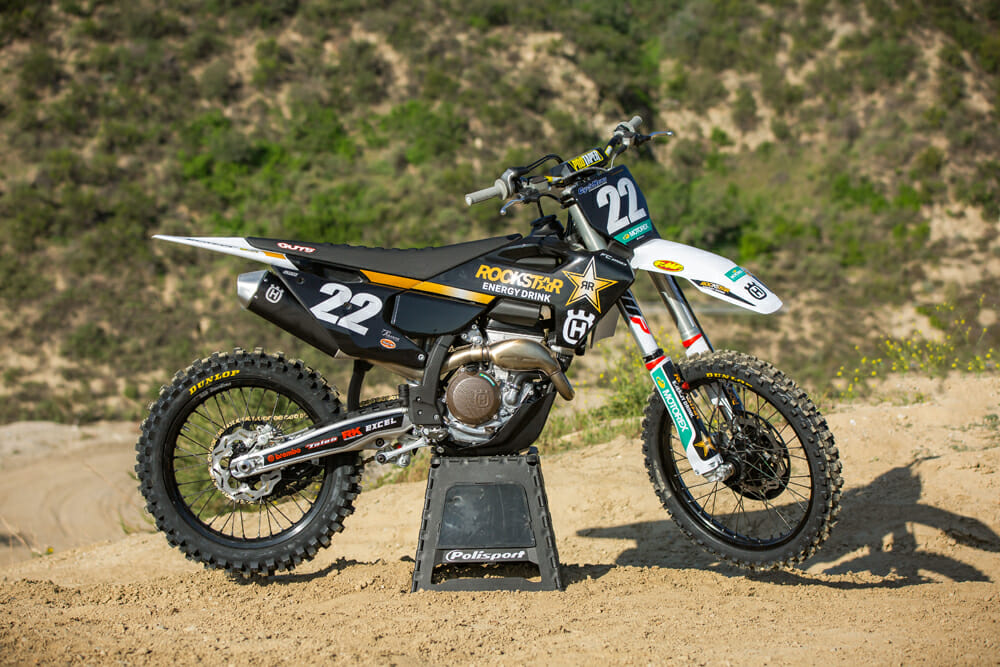 The Husqvarna FC 250 Rockstar Edition shares the same updates as the KTM 250 SX-F Factory Edition. They are, in fact, nearly identical machines, closer than ever.
The Husqvarna FC 250 Rockstar Edition shares the same updates as the KTM 250 SX-F Factory Edition. They are, in fact, nearly identical machines, closer than ever.
We first focused on the FC 250. (We will talk about the 450 in a future issue.) The smaller of the two Rockstars got a whole host of new hardware versus the standard FC 250. Upgrades to the engine, suspension and chassis highlight the bike’s refinements, and it looks much different at first glance. The powerplant is shorter in length and height for a more compact center of gravity while being rotated two degrees to combat squatting under power.
Inside, there’s a shorter stroke and larger bore to match, aimed at giving the bike more grunt down low while still retaining that 14,000-rpm rev-limiter that we’ve come to know from the Austrians. A new streamlined electronics package complements the engine with updated mapping, traction control and a quickshifter. The quickshifter is an on/off setting run by a sensor on the shift drum that temporarily cuts ignition and allows the bike to shift up under load. It’s trick technology that’s poured over from the road-racing world.
WP continues to supply the suspension components for the Husky, riding on updated Xact forks and a new Xact shock. The 48mm forks are the same ones from the previous-generation machine but now come with updated settings geared for better bottoming resistance. The shock is 15mm shorter but still provides the same amount of travel while being 100 grams lighter. Both the fork and shock now come standard with plastic dial adjusters rather than the traditional clickers that require a screwdriver.
Finally, these components are mounted to a new black frame that features a new “spine-less” design. Husqvarna ditched the previous frame design with a backbone that ran from the shock mounts all the way up to the headtube. There’s a new shock tower for the new-gen bike that transfers load down the sides of the frame rather than up into the handlebars. Wider and more recessed footpegs are found at the bottom of the cockpit, while ProTaper handlebars and ODI grips control the front of the bike.
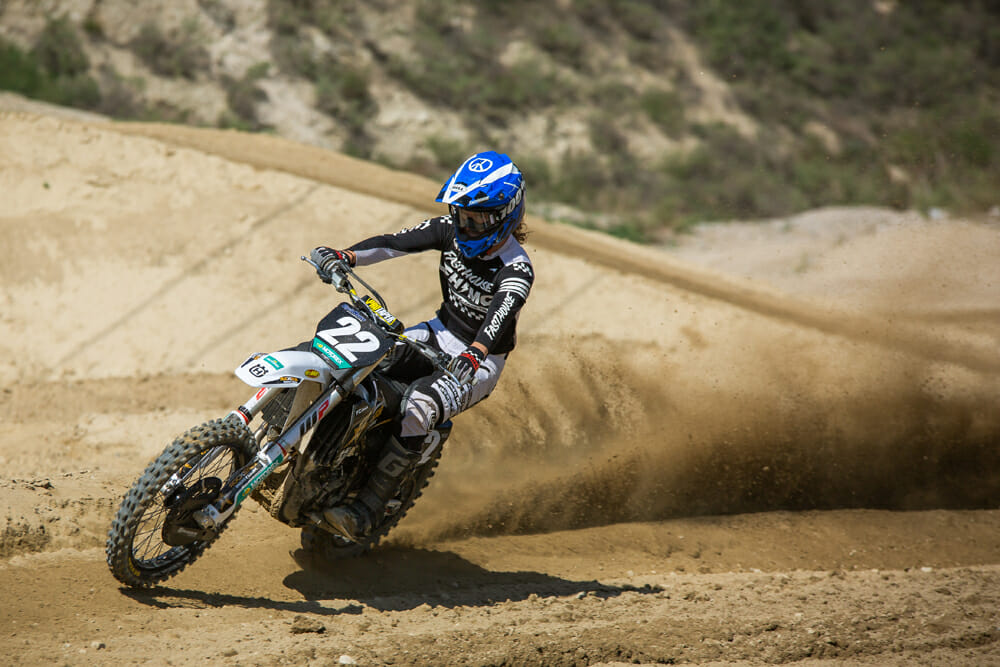 Grab a handful and the Husqvarna responds.
Grab a handful and the Husqvarna responds.
This all sounds familiar, right? It should. If you read our review for the 2022 KTM 250 SX-F Factory Edition, you might think that you’re reading double. Not to worry, there’s no need to get your eyes checked just yet. That’s because the Husqvarna received the same mechanical changes as its orange brother. The frame, engine, swingarm, suspension and electronics are virtually identical on both bikes.
In years past, we’ve busted the “white KTM” myth with a simple analogy to the car industry. General Motors offers three similar brands, Cadillac, GMC and Chevy, all with different trim packages and price points. The KTM Group practically adopted this mentality with its three brands. The Husqvarna is the Cadillac, the KTM is the GMC, and the GasGas is the Chevy. All are very similar but still different in their own ways.
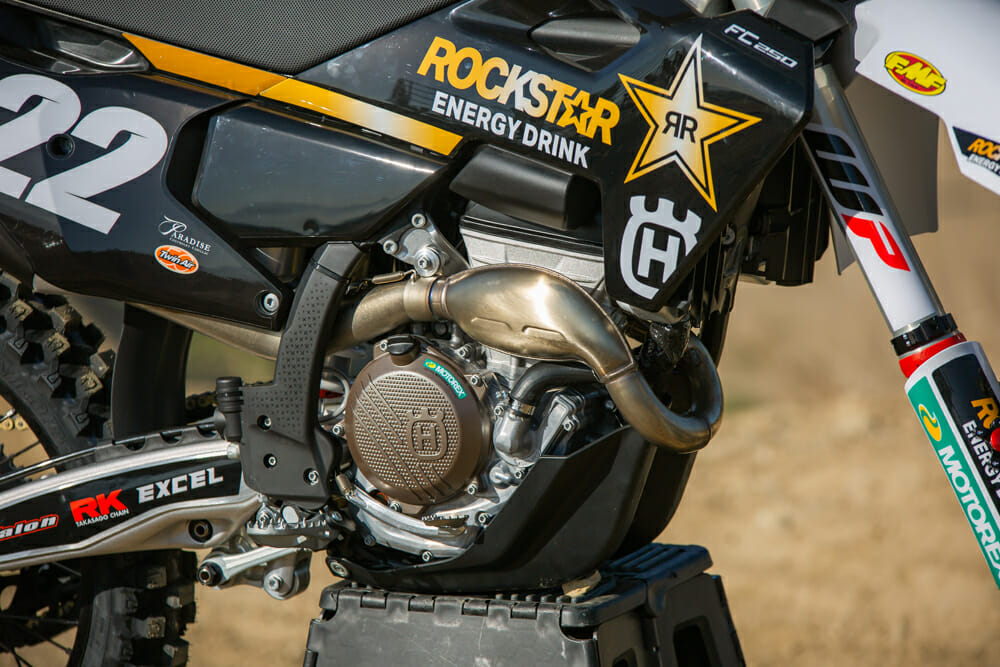 The motor is all-new and even sits in the frame differently.
The motor is all-new and even sits in the frame differently.
The differences in these machines, however, are getting smaller and smaller. For 2022, the GasGas brand maintains the “current” generation chassis/engine combo, while the KTM and the Husqvarna are moving forward with a new-generation unit, as seen on the Factory/Rockstar Edition bikes. In fact, the only differences now between the KTM and the Husqvarna are the bodywork, the color options and the handlebars. The bodywork on the KTM is a new design that’s much sharper, while the Husky now comes with a plastic shock cover and more overall plastic surface area for the rider to hold onto. In that vein, the airbox is sealed off on the FC while it’s totally open on the SX-F. The Husqvarna is obviously white and black with Factory Rockstar graphics instead of the orange Red Bull combo. The last significant difference is the Husqvarna’s ProTaper handlebars versus the KTM’s Neken setup.
The Rockstar Edition is Husqvarna’s enlistee in the Factory Edition fight. It rolls off the showroom floor with black-on-black D.I.D Dirt Star wheels, black-anodized split triple clamps, Rockstar graphics, a gripper seat cover, a holeshot device, a skid plate and a factory front disc cover. Lots of goodies, that’s for sure. Along with that, you are getting the latest and greatest without having to wait for the 2023 production model.
Rolling out from the pits is where most of these changes become visible. The cockpit is slim and noticeably more comfortable with the new seat and footpeg design. The hard edge of the seat is different from the flatter, rounder design from before and offers a more distinct feel for where you are on the bike. The pegs now have a wider platform and are mounted at an angle that makes them easier to find for riders with bigger feet. Radiator shrouds are like the previous generation, but the larger “contact patches” around the shock, airbox and rear number-plate area are felt right away. The updated map switch is also a nice touch as all the control buttons are located on one Apple-slim clamp near your left thumb. Release the butter-smooth Brembo hydraulic clutch, and it’s time to spin some laps.
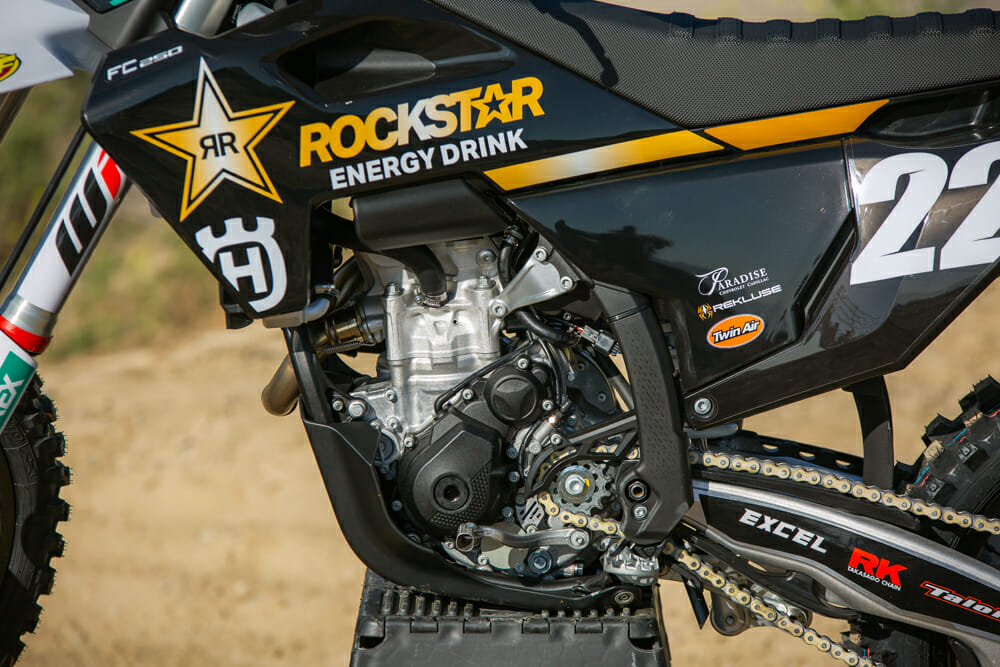 The Rockstar Edition rolls off the showroom floor with a solid airbox cover but they hand you a vented one, as well.
The Rockstar Edition rolls off the showroom floor with a solid airbox cover but they hand you a vented one, as well.
The start-straight at Glen Helen Raceway was the perfect place for the new FC to stretch its legs. It’s hard to imagine the high-revving Austrian engines being anything but that. Their powerplants have been notorious screamers with tons of top-end pull but maybe lacked that low-end torque compared to the Yamaha YZ250F. The Husky now pulls much more from the bottom- to mid-rpm range, thanks to its internal updates. The maps are distinctly different from before, when maps one and two felt eerily similar. Now map one is that familiar top-end heavy KTM character, while the second map is obviously the more aggressive option. It packs better snap down low without sacrificing anything in the upper area of the rpm. This second map is also where you’ll find that harder-hitting low-end punch that rivals the Japanese bikes.
The quickshifter is another trick option you’ll find on the Husqvarna. We were able to get our bearings straight with this new tech after spending some time on the new KTM and felt comfortable using it on the FC. It feels more useful on the power-hungry 250 machines, especially on a track like Glen Helen that demands every last horsepower. You can easily grab the next gear under power without worrying about damaging the engine. This allows you to carry more momentum while never letting off the throttle. If you’re not a fan, simply click the button and turn it off.
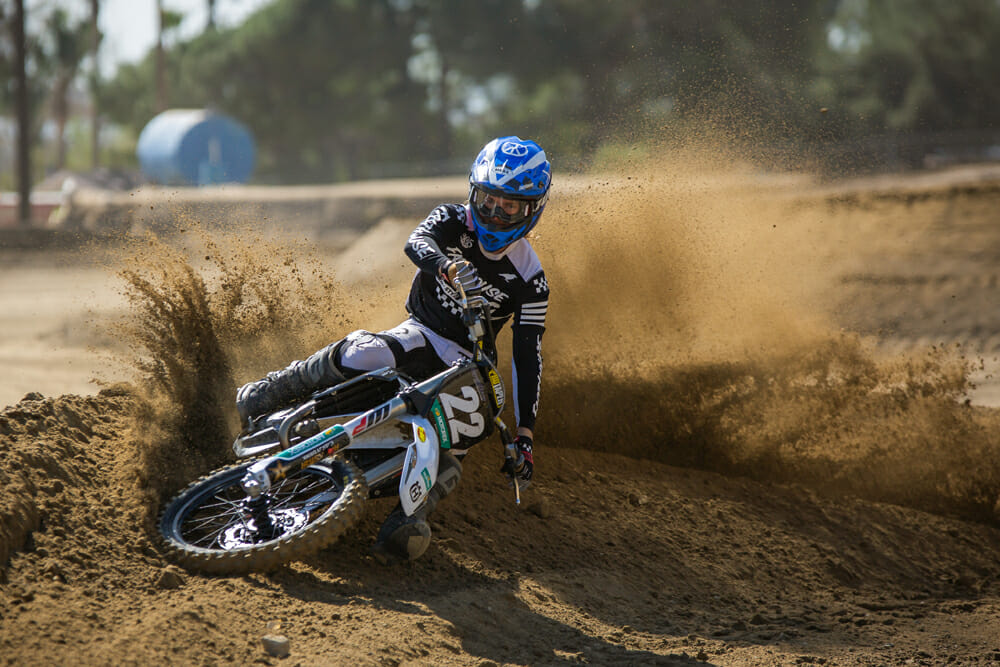 The Rockstar Edition gained a little weight over the standard FC 250, but you won’t care.
The Rockstar Edition gained a little weight over the standard FC 250, but you won’t care.
The only real drawback, if you want to call it that, came when I tested the quickshifter against a traditional “speed-shift”—you know, when you hold the throttle on, pull the clutch in, shift, and let the clutch out, all while the throttle stays pegged. This millisecond of clutching under power allows the revs to spike, so you’re already in the desired rpm range when you click up into the next gear. With the quickshifter, there’s no clutch action, so moving up to the next gear feels like you are actually dropping in the revs. I chalk up the quickshifter as an overall positive and think this “bog” just might take some more getting used to.
This version of the air fork is the best version we’ve felt. Its compliance in the small bumps is better than in years past and feels closely matched to that of a spring system. The fork has felt vague on former models, but these new settings give a more planted feeling that allows for easier rider input. Neither of our riders had any negative feedback on the shock. It continues to work as expected while providing a planted, connected feel to the rear wheel from the throttle. The new dial adjusters are also a welcomed change as we played with clicker settings on the side of the track instead of trekking back to the pits and toolbox.
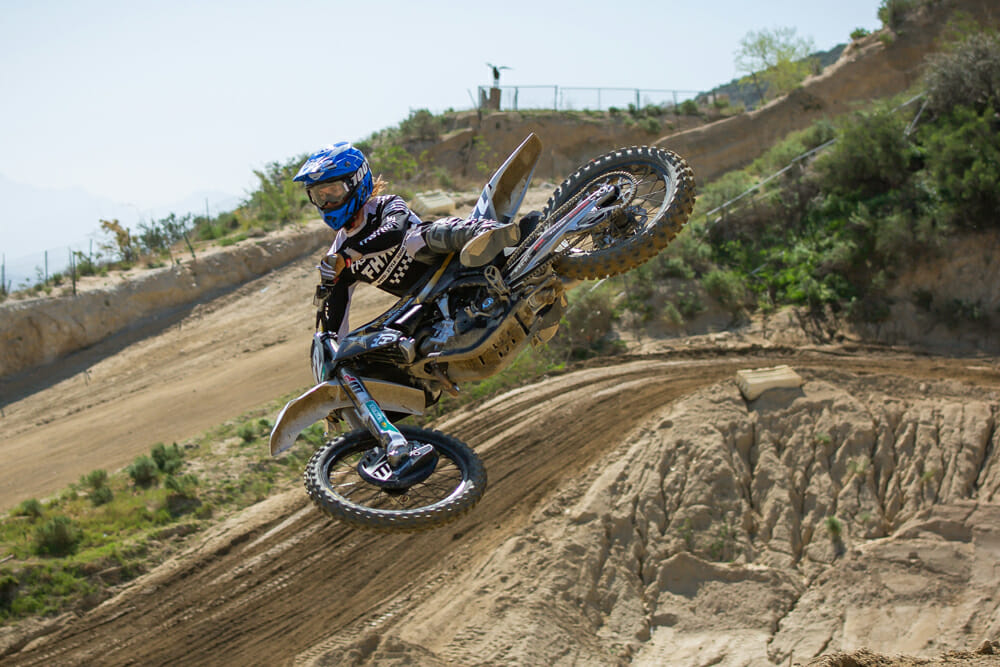 The Husky’s WP Xact Aer fork just keeps getting better and better.
The Husky’s WP Xact Aer fork just keeps getting better and better.
The brakes and clutch are again top-notch on the Husqvarna. Brembo componentry is some of the best in the business, and the steel-braided brake lines provide sturdy power when you need it most. Going fast on the FC 250 is plain easy. It’s smooth and predictable and goes where you want it. The only real complaint we had was how “long” the bike felt. The new Honda 250F feels shorter in the wheelbase, whereas the Husqvarna feels longer yet more stable in the faster areas of the track. Not bad, just “ism’s.”
Overall, the new FC 250 looks and feels strikingly similar to the new 250 SX-F, which is not a bad thing at all. The motor is better in all the right places, and the fork is the best version we’ve ridden to date. While it technically gained weight from the previous generation, the Husqvarna still feels noticeably light and nimble on the track.
After our first ride on the new Husqvarna FC 250 Rockstar Edition, we can safely say, so far so good. CN
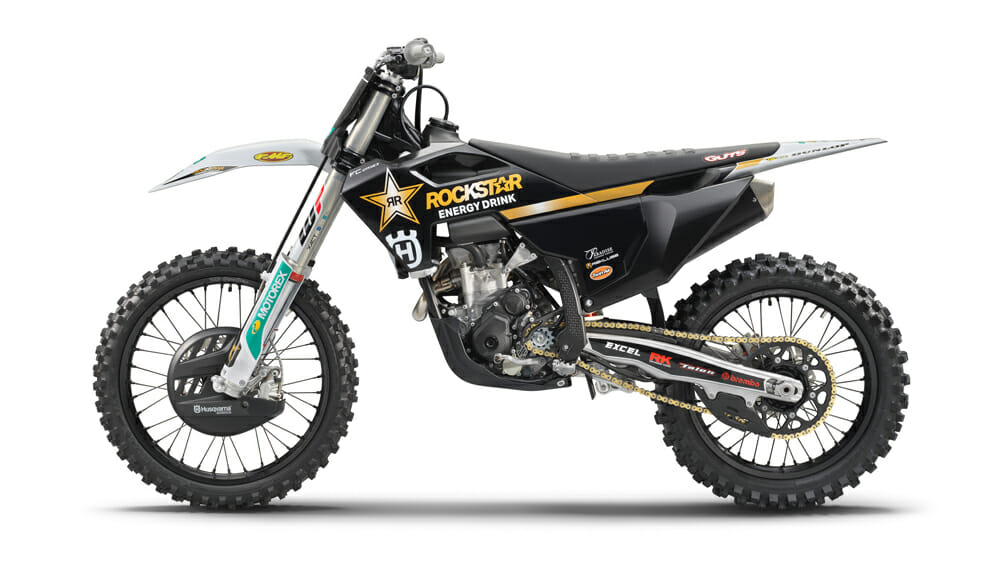
2022 Husqvarna FC 250 Rockstar Edition Specifications
| MSRP |
$10,699 |
| Engine Type |
4-stroke, single-cylinder |
| Cooling System |
Liquid |
| Displacement |
249.9cc |
| Bore x Stroke |
81 x 48.5mm |
| Compression Ratio |
14.5:1 |
| Valvetrain |
DOHC, 4 valves |
| Starting System |
Electric |
| Fueling |
Keihin EMS |
| Transmission |
5-speed, w/ quickshifter |
| Clutch |
Brembo, Hydraulic |
| Frame |
Steel central-tube frame |
| Subframe |
Plastic frame, aluminum mounting |
| Handlebar |
ProTaper |
| Front Suspension |
48mm WP Xact |
| Rear Suspension |
WP Xact monoshock with linkage, fully adjustable |
| Front-Wheel Travel |
12.2 in. |
| Rear-Wheel Travel |
11.8 in. |
| Front Wheel |
21 in. |
| Rear Wheel |
19 in. |
| Tires |
Dunlop Geomax MX33 |
| Front Brake |
Single 260mm Brembo |
| Rear Brake |
Single 220mm Brembo |
| Triple Clamps |
Split-design, anodized black |
| Seat Height |
37.5 in. |
| Ground Clearance |
13.4 in. |
| Fuel Capacity |
1.9 gal. |
| Weight (dry, claimed) |
225.1 lbs. |
